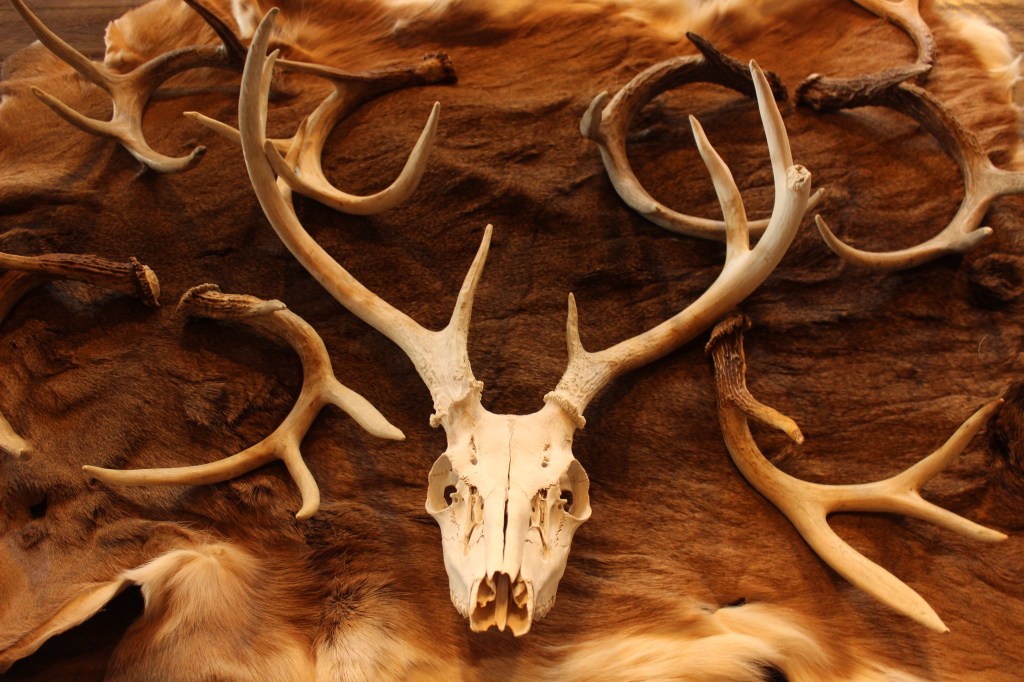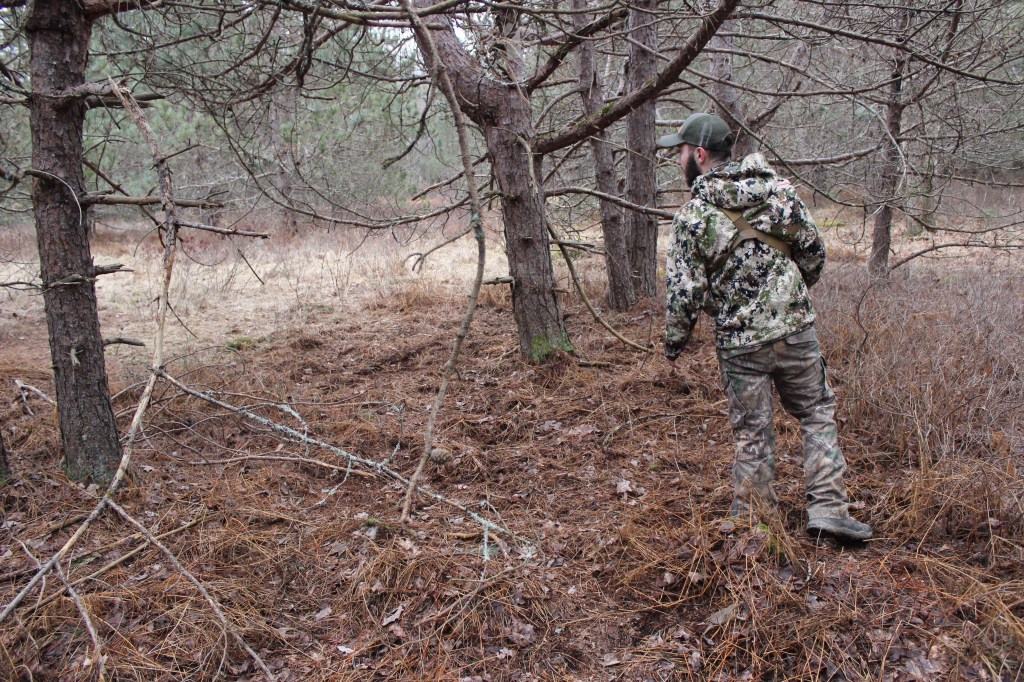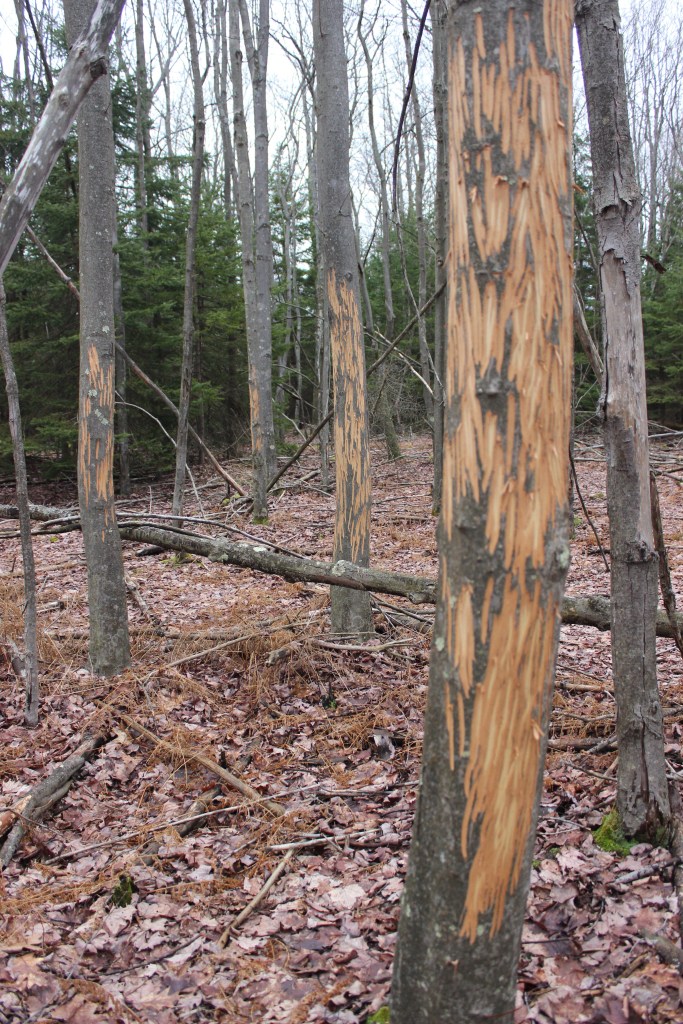Searching for Sheds

I’ve been hunting in the woods lately, but without a firearm or a bow. Vernal pools are boiling with mating wood frogs. Honking geese fill the skies. Trees have not yet begun to bud so the sun is warm on your face. March is a fine time to be in the forest, a fine time to look for antler sheds. I imagine them in the forest duff, tucked under leaves, protruding like a bare stick. I hold them in my mind’s eye.
I walk the woods roads on the Blue Mountain until I intercept beaten down game trails that look nearly as well-trodden as the Appalachian Trail. I follow them and slow to a wander, ducking under branches like a buck would have to, detouring around large blow-downs. I pass a pile of dung pellets, a rub on a sapling- the bark missing, its trunk raw and exposed. Deer passed here, and maybe one dropped their antlers not too long ago.
Both the growth and the casting of antlers is controlled by photoperiods (length of time sunlight is absorbed) and testosterone levels. After the rut, an “abscission layer” forms between the antlers and their pedicels. When the connective tissue dissolves, the antlers loosen and fall off.
Finding a shed can give valuable information for next season’s hunting spots. An early find, say in February, are typically dropped by more mature, dominant bucks (with larger racks and more depleted testosterone levels), but the most productive time to shed hunt seems to be in the middle weeks of March. Any activity that makes us decelerate our fast-paced life, and get outdoors however, should be celebrated and practiced.
Both of my neighbors here on Red Mountain, Terry Becker and Josh Dolbin, are avid hunters and have agreed to take me out and teach me what they know, as well as Zack Zawada, who has an expansive private forest right out his back door. Later in the spring, I will also shadow an elk shed hunter up in Elk County.
Terry and I head to one of his favorite hunting areas in Weiser State Forest. Since the winter or 2019-20 was very mild, the buck behaved differently, Terry informs me. They did not yard up as they usually do, under heavy hemlocks and pines where it is warmer and the snow is not as deep. In a harsh winter, they’ll spend great amounts of time lying in there and those locations are where shed hunters usually look first, but not this year. Instead, the bucks roamed, thereby making sheds more difficult to find.
Terry explains that you have to first know where the deer travel, where they bed down, where their food source is. You can only learn this by spending time in the woods. In the winter, deer want cover and food. Find these places. Perhaps locate a corn field that still has some waste corn in it. Starting here, gives you a higher success rate.
We notice where the deer stirred up the forest floor, overturned the leaves and walked through. In a cleared area, they pawed the ground looking for food and minerals. Small green leaves coming up under the leaves are what the deer are looking for. We walk a grid design in these areas being extra thorough. Most of the acorns are wormy at this time of year. With a pocket knife, Terry slices a few in half that looked healthy but are punky and have no meat inside. Still, looking for sheds on mature oak ridges with a good acorn crop still on the ground are good locations. Deer seem to prefer maple branches as browse, perhaps because at this time of year, the flowing sap is slightly sweet. Nipped off edges of twigs are signs they are eating here. Rubs show where they are marking, not eating. The bigger the buck rub, the bigger the buck- usually.
Buck don’t necessarily walk a game trail but are in the vicinity of them. They travel the same trails as the does in the winter but branch off on their own other times of the year. Look in the area of a well-traveled game trail, Terry tells me. When you find a travel route, they often walk on either side.
Antlers can be many different colors from beige to chocolate. Sometimes they are lying right on top of the forest floor or only have a single tine sticking out. Buck often lose their antlers when they bump something or get them caught on a branch. Looking for a shed is like looking for a needle in a haystack. Last year’s sheds are hard to find. Small animals eat them and porcupines are especially hard on them. We find other animal signs as we search for sheds- a hole in the ground where a fox or a coyote was trying to dig out a critter.
“You need to try to think like a buck,” Terry says, “If I were a buck, I’d be lying right here in this sundrenched, overgrown grass field.” We find small beds, which indicates a small deer; perhaps a mom and her young. We find deer hairs in the matted-down beds.
“You learn a lot about wildlife by just being in the woods,” Terry says. “The more time you spend there, the more you learn,” Terry says. “Then you can learn how the population is doing and hunt them better,” and to that I add, “Or just spend an enjoyable morning in the woods.”

Before I go shed hunting with my neighbor, Josh Dolbin, he gives his labradoodle, Rosie, a shed to sniff and understand what she is supposed to find. In the woods, Rosie is in dog heaven, running the deer trails with her nose down, sniffing ferociously. (Dogs can be a big asset to shed hunting).
Josh has 26 acres and walks right out his backdoor to hunt. After snow covers the ground, he returns to the woods, walking the game trails- to the deer bedding and feeding areas and gets a lot of information about their habits. “You come to understand how they run. They travel down into this hollow when they are pressured or pushed. They look for good cover. They lay on the sunny side of the mountain.”
We travel into the thick shrub cover. On a sunny flat, we find lots of scratchings, and Josh teaches me the difference between turkey and deer scratchings.
“As the forest changes, the deer change their trails. If a big tree falls, the deer travel around it. They don’t usually go over a tree. They don’t expend their energy if they don’t have to. A deer is like a person- they typically want to travel the easiest route possible, browsing as they go.”
We zig zag on a sunny flat of pines and find tons of sign, droppings, twigs sheared off and a bleached leg bone, but no sheds.
“I hunt differently now,” Josh explains, “I let a whole lot more deer go by and am more selective. I spend more time watching deer than shooting them and because of it, I’ve gained a better understanding of how these critters work,” and that is a gift in itself.

Zack Zawada begins looking for sheds in mid-February. He owns 20 acres in Schuylkill County and behind him is 100 more that he can access. He has half a dozen trail cameras mounted and watches the bachelor groups as they come out to feed together, sometimes in groups of 3-6. He knows when the antlers are on and when they fall off. On his camera, he has captured 10-12 different buck. He looks at his camera card readers once a week and in that time, sees 164 photos. Zach used battery cameras for solar ones cost $400, he tells me, and people steal them, even on private property.
“I enjoy finding sheds and seeing what is out there.” One time his labs found a tiny fawn up on a hemlock tree branch, placed there by a bobcat which then fled. When he finds corn cobs in the woods, he knows a buck got a cob stuck in its antler and carried it into the woods. We find a branch which a buck broke and licked. And although Zach has found many nice sheds on this property, some stuck in the rhododendron, we find none today, but we do have a good time in the woods.

Jimmy Shirey started shed hunting with his father when he was 17 years old. “I saw my first elk shed poking out of the grass 70 yards away and yelled, ‘Dad, I got one!’ That was it, I was hooked.” A few months later he found a matching set. At 24 years old, he is one of the best. His hunting grounds are the 1000 acres of reclaimed mine lands/elf refuge in Elk County near Benezette.
Jimmy hunts sheds for both deer and elk and there are two different tactics for the two different species. Deer follow more of a pattern. Elk are more random in their movements. They do and don’t do trails. In bad winters, the elk do not move a ton. Once the grass greens up, they move a lot. Their movement is more rapid and they pick it up over time. Jimmy deer shed hunts in Feb but doesn’t touch elk until March-May. After that, the grass is too high.
Every shed hunter has their own strategy. Some guys use trail cameras religiously, even on state game lands. Jimmy does not use trail cameras, but goes with his eyes. He knows where he is on the land, knows what property he is on, and can see the lay out of the land on topo maps on his phone. He is out searching every chance he gets and puts about 100 miles a week on his boots. Besides walking, Jimmy does a lot of driving. “This is an expensive hobby,” he says, “I spend a ton on gas, driving between 500-1,000 miles in a week. My truck is only 6 months old and I already have 18,500 miles on it!”
“Except for during the rut, when they can’t stand to look at each other, the bulls are in bachelor groups. I watch the bachelor groups and study the individual animals. One group might have a bull with a small rag horn, another a weird antler characteristic. I notice individual things, takes photos of them and get to see and know them as individual bulls.” He has a degree in wildlife management and although he does not work a job with it, he uses his education as a shed hunter.
“Every bull in this early season, could be dropping their racks. When I see 6 bulls bedded in a field, I think there could be an antler laying in there come morning, but every bull is being watched by 25-50 shed hunters. The early bird gets the worm in this case. Elk Shed hunting is a very secretive sport, Jimmy tells me. When he began, 5-6 guys practiced it, but about a dozen years ago, the competition increased. Now, even 3-4 women shed hunt regularly.

The day we select to hunt is overcast and grey, good weather for shed hunting, Jimmy tells me. “Light is a big factor when looking for sheds, whether deer or elk. You could be within 10 ft of a shed but if you are walking into the light, you might never see it; the glare kills you.” We begin our search in a transition area- an open area between thick mountain laurel and evergreens. The red twigs of blueberry bushes are good browse and we see many branches that are snipped off. We find areas where the animals are digging up roots, seeds, and minerals, but no sheds.
“This is like an adult Easter egg hunt. You are not promised anything. It can be frustrating, anything you take seriously can be frustrating. But I get really driven to do this.” In this particular area, there are both deer and elk and Jimmy tells me it is a challenge to learn the signs of both.
In the beginning of his shed hunting career, Jimmy only found old antlers. Last year he found one old and nine new. Jimmy already found a shed so recent that the stump was bloody. Some smell strongly musky, they are so fresh. Every antler is 100% unique, like a finger print. Some have battle scars from fighting, and they tell a story. Jimmy has witnessed two elk fights in his time in the woods. Unlike some states, you cannot legally sell elk antlers in PA. He was already offered $5,000 for one set but will not sell, nor can he bring himself to drill a hole in an antler to make a chandelier.
In the last five years, elk shed hunting sport has really grown, fueled by online social media. Jimmy exchanges tips and hints with some hunters and it’s helped him be more successful. Now when you see a truck parked by the road at this time of the year, he tells me, you can be sure they are shed hunting. More shed hunters translates into more hardship on the animals, however. They chase them, trying to get them to move. Jimmy, on the other hand, respects the elk.

“By the end of the month of March, it will be a shit show up in the elk range as shed hunters descend on weekends. Six bulls mean 12 pieces. On public state game lands, a shed hunter walked up to Jimmy who had a small side in his hand and demanded, “Where did you find that?”
When he told him he replied, “You know, you’re not allowed to be here.” Jimmy asked why, for its public land, and he replied, “You just can’t. I hunt in there and have a tree stand and it’s MY area.” This guy was 50+ years and trying to intimidate Jimmy since he’s younger.
“I try to keep my cool but these guys are aggressive. A few men have gotten smart with me. I also had guys wing in and park behind my truck; jump out and run ahead of me, trying to cover more ground than me. It gets worse every year.”
That heightened state of awareness and alertness has to open you up to other moments of magic too. He stumbled across a bear den already and saw owls perched in the trees above him. Jimmy’s shed hunting developed into an interest in photography and he learned that he could hunt wildlife in a different way other than with a gun. He is now good enough to sell his photographs and has been hired to shoot weddings.
“My biggest tip for shed hunters… train the eye to see. Don’t rule anywhere out to find antlers. Think of an animal’s needs – cover and food- and that is where they will spend their time. They will spend 70% of their day there so your odds are good to find them. Don’t rule anywhere out to find antlers.”
“Shed hunting is my release, my relaxation. I learn every time I am outside and it’s a hellava lot better than work and sitting indoors!”
If you take up shed hunting this spring and are unsuccessful, take heart, it happens every year and since antlers are the fastest growing body part (two inches a day), there’s always more to look forward to.

(A version of this story appeared in the recent issue of Pennsylvania Game News Magazine).
Posted in: Uncategorized

Really great piece😄
Sent from my iPad
>
thank you, my dear- miss you all very much
thank you Miguel
Really enjoyed that post! Learned a lot!!!!
Sent from my iPhone
>
thank you!
thank you dear- miss you!
Beautiful photo and very interesting story.
thank you dear- miss you